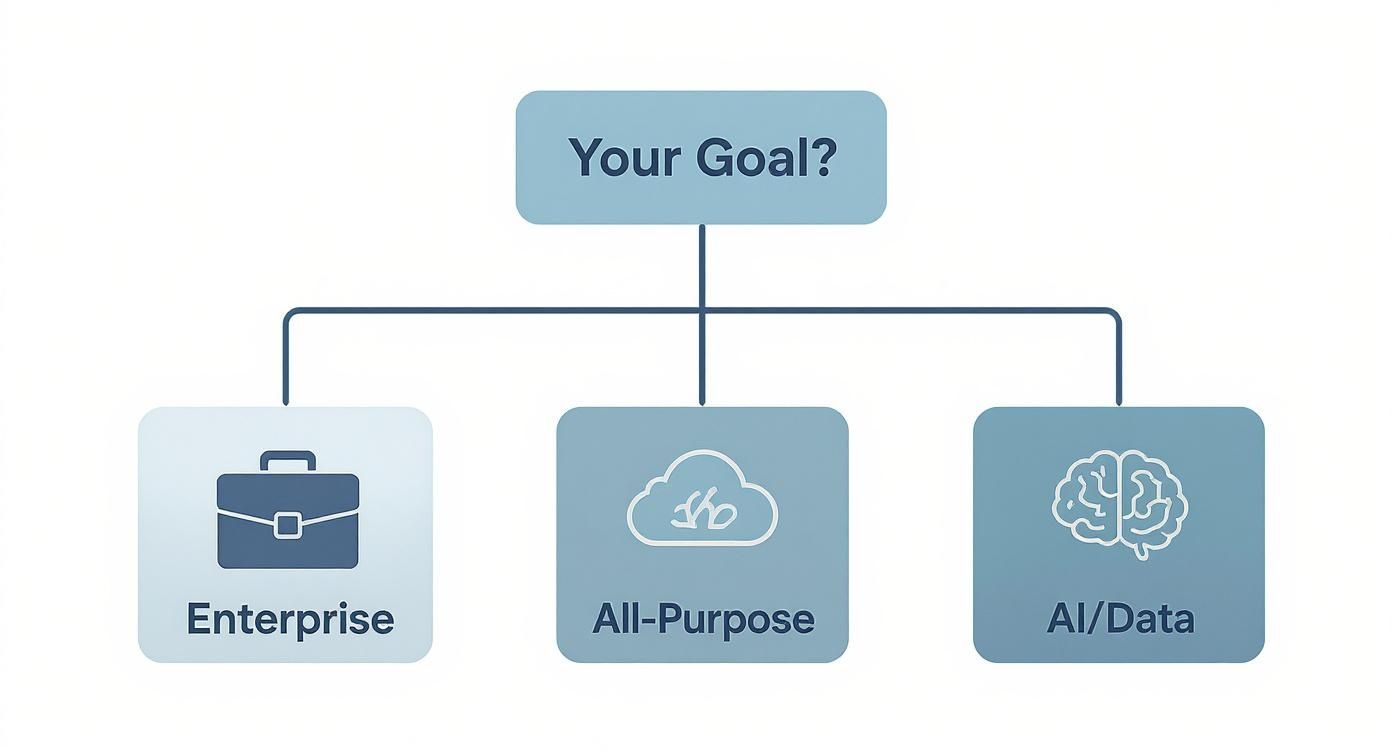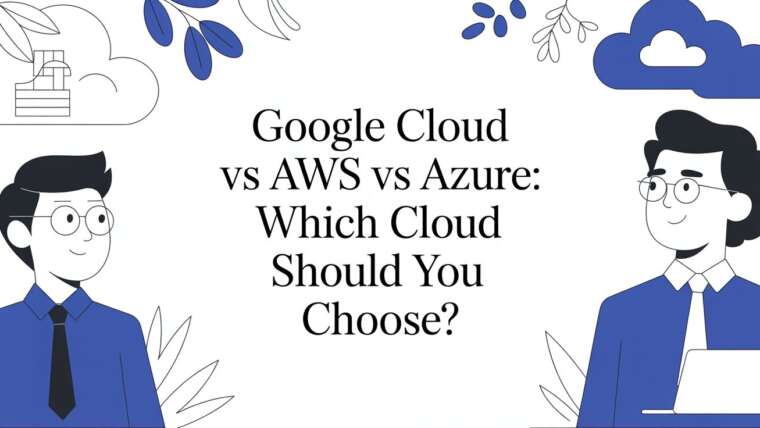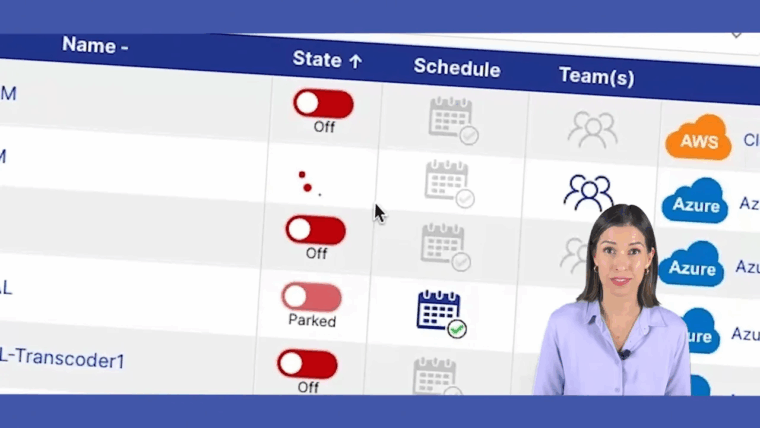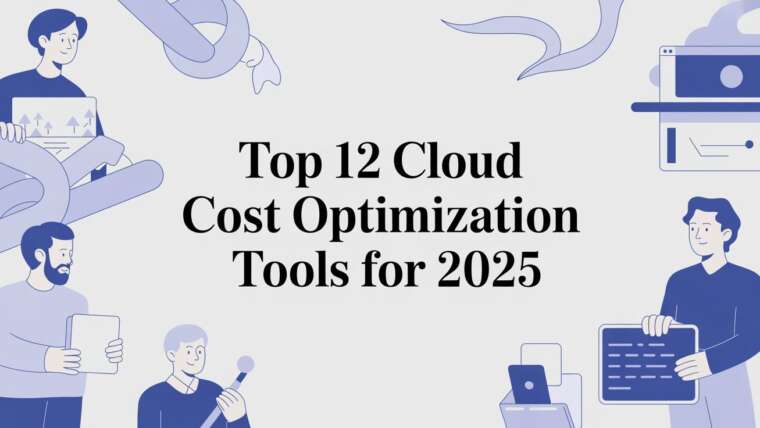When you look at the cloud providers market share, it’s a story dominated by three titans: Amazon Web Services (AWS), Microsoft Azure, and Google Cloud. You’ll often hear them called the 'Big Three', and for good reason. Together, they command over 60% of the entire global cloud infrastructure market, with AWS still holding the top spot. For any business trying to pick a cloud partner, understanding these power dynamics is absolutely essential.
Understanding The Cloud Market Landscape
The cloud computing industry hasn't just grown; it's become the very foundation of how modern businesses operate. The fierce competition for market share isn't just noise. It directly shapes the services, pricing, and innovation you see from each provider. And that, in turn, has a real impact on the technology decisions you make every day.

The market's expansion is impossible to ignore. The latest data from the second quarter of 2025 shows the Big Three's commanding lead in a market that hit $99 billion in that quarter alone, a massive 25% jump from the previous year.
A huge driver for this recent surge has been the AI boom, which has sent demand for specialized cloud services through the roof. The numbers paint a clear picture: AWS holds strong with approximately 30% of the market, followed by Microsoft Azure at 20%, and Google Cloud with 13%. You can dig deeper into these trends in cloud infrastructure spending on Statista.
Why Market Share Matters
Looking at market share isn't just some academic exercise. It gives you practical clues about a provider's stability, the maturity of its ecosystem, and its staying power for the long haul. A bigger slice of the market usually means a few things:
- A more sprawling global infrastructure, which translates to lower latency and better coverage no matter where your users are.
- A deeper, more mature portfolio of services and features that have been battle-tested.
- A massive community of users, which means a richer pool of third-party tools, integrations, and available talent.
A provider's market position is often a solid indicator of its reliability and the depth of its ecosystem. For a business, this means less risk and more access to resources, making market share a genuinely critical factor in the decision-making process.
To give you a clearer picture, here’s a quick breakdown of where the top players stand right now.
Current Cloud Market Share Snapshot
This table summarizes the latest market share figures and highlights what makes each of the leading providers stand out.
| Cloud Provider | Market Share Percentage | Key Strength |
|---|---|---|
| Amazon Web Services (AWS) | 30% | Comprehensive service portfolio and first-mover advantage |
| Microsoft Azure | 20% | Strong enterprise integration and hybrid cloud solutions |
| Google Cloud | 13% | Expertise in data analytics, AI, and machine learning |
This high-level view sets the stage, but the numbers only tell part of the story. It's the strategic differences behind these figures that will ultimately guide you to the right choice for your company's unique needs.
Decoding the Strategies of the Big Three
To really understand cloud provider market share, you have to look past the simple percentages. Those numbers are the direct result of distinct, deeply ingrained business philosophies. Each of the Big Three is playing a different game, targeting specific types of customers and using their own unique history to defend and grow their position.
Amazon Web Services (AWS) is the established incumbent. Its strategy is built on a powerful first-mover advantage, giving it the most expansive and mature portfolio of services on the market. This sheer breadth creates a powerful defensive moat, making it the default choice for startups and enterprises that value a massive, time-tested toolkit above all else.
AWS: The Comprehensive Supermarket
Think of AWS as a massive supermarket for cloud services. Whatever you need, from basic computing and storage to niche quantum computing tools, it almost certainly has a product for it. This all-in-one approach is a magnet for a wide customer base, as teams know they can find a solution for nearly any technical challenge without ever leaving the ecosystem.
This strategy of immense scale and variety has cemented its leading market position. But that vastness can sometimes feel overwhelming, which creates openings for competitors offering more focused, specialized solutions.
Azure: The Enterprise Integrator
Microsoft Azure’s strategy is a masterclass in leveraging an existing empire. Its playbook is all about seamless integration with the Microsoft products that countless enterprises already rely on, like Office 365 and Windows Server. For large organizations deeply embedded in the Microsoft world, adopting Azure is simply the path of least resistance.
Azure’s strong focus on hybrid cloud is another key differentiator. It provides powerful tools for businesses that want to merge their on-premises data centers with public cloud resources, a very common scenario in large, established companies. This dedication to enterprise needs and hybrid flexibility is exactly how Azure consistently challenges AWS's dominance. Of course, managing costs in this ecosystem is critical, and getting an overview of Azure pricing for essential services like blob storage can help you understand its structure.
Google Cloud: The Innovation Specialist
While Google Cloud Platform (GCP) has a smaller piece of the market share pie, its strategy is to win on technical superiority in specific, high-growth areas. It leans heavily on its deep-rooted expertise in data analytics, AI, and machine learning. For companies where data is the core product, GCP presents a compelling, and often best-in-class, set of tools.
Google Cloud's core strategy isn't to out-compete AWS on the sheer volume of services. Instead, it aims to lead in innovation-driven fields, attracting customers who need elite performance in areas like big data processing and AI. It's the specialist's choice.
These distinct strategies are fundamental to understanding the cloud market. AWS offers unmatched breadth with over 200 services and a global footprint of over 100 Availability Zones. Meanwhile, Azure leverages its enterprise ecosystem and hybrid cloud strength across its 116+ Availability Zones, while Google Cloud carves out its niche with cutting-edge AI and data services. Each approach directly shapes their offerings and explains why they appeal to very different segments of the market.
How Market Share Impacts Your Real-World Use Case
Cloud market share isn't just a number for investors to watch; it has a direct impact on your experience as a buyer. When a provider like AWS has a commanding lead, it means they have a massive, mature ecosystem that’s been battle-tested for nearly two decades. That kind of history translates into real-world stability and a dizzying array of tools.
If you're a startup trying to build and scale fast, AWS often feels like the default choice for a reason. With over 200 services, they have a ready-made solution for just about any problem you can throw at them, from basic compute to sophisticated machine learning. Your engineers can move quickly without wasting time patching together services from different vendors.
This infographic breaks down the choice into a simple decision tree, connecting your main business goals to the provider that’s likely the best fit.

Think of it as a quick cheat sheet. It helps cut through the noise by linking what you want to achieve with the provider best equipped to get you there, making that initial choice a lot less intimidating.
Aligning Provider Strengths With Business Goals
While AWS has built its reputation as the do-everything platform, Microsoft Azure has smartly carved out a powerful niche in the enterprise world. Its market share is fueled by its deep, native integration with the Microsoft software that already runs most large companies, think Office 365 and Windows Server.
Imagine a large corporation that's been a Microsoft shop for decades. For them, moving to Azure is less of a leap and more of a natural next step. The advantages are immediate and compelling:
- Unified Identity Management: Active Directory just works, simplifying user access and security across on-prem and cloud.
- Seamless Hybrid Cloud Capabilities: Tools like Azure Arc are built from the ground up to manage resources in their own data centers right alongside cloud services.
- Favorable Licensing Terms: Existing enterprise agreements often roll into Azure, delivering serious cost savings right off the bat.
These built-in advantages make Azure the path of least resistance for many established businesses, cementing its solid #2 position. Of course, managing these resources effectively is a whole other challenge, and our guide on cloud computing management services offers some great advice on how to stay in control.
When Niche Expertise Outweighs Market Leadership
Then there's Google Cloud Platform (GCP), which proves that a smaller market share doesn't mean a weaker product. In fact, it’s quite the opposite. GCP has strategically focused on being the absolute best in a few key areas: data analytics, artificial intelligence, and container orchestration with Kubernetes.
For a business whose core product revolves around processing massive datasets or building advanced AI models, GCP's technical superiority in these areas can be the single most important factor, making market share percentages secondary to raw performance.
For instance, a fintech company building a real-time fraud detection engine would get a massive leg up from Google's BigQuery and AI Platform. In that context, having the best-specialized tool for the job creates a competitive advantage that easily outweighs the broader ecosystem of AWS or the enterprise convenience of Azure. It’s a perfect reminder that you have to look past the market share numbers and focus on what your specific project truly needs to succeed.
To help clarify this, the table below maps common business scenarios to the most suitable provider.
Provider Strengths By Use Case
| Use Case | Recommended Provider | Reasoning |
|---|---|---|
| Rapid Prototyping & Startups | AWS | Its vast service portfolio and mature ecosystem provide ready-made solutions for almost any technical challenge, accelerating development. |
| Large Enterprise & Hybrid Cloud | Azure | Deep integration with existing Microsoft products (Windows Server, Office 365, Active Directory) creates a seamless transition and unified management. |
| Data Analytics & Machine Learning | GCP | Offers best-in-class, specialized services like BigQuery and AI Platform that deliver superior performance for data-intensive workloads. |
| Containerized Applications | GCP | As the original creator of Kubernetes, Google's GKE is widely considered the most mature and robust managed Kubernetes service available. |
| Global E-commerce Platform | AWS | Unmatched global infrastructure, reliability, and a broad set of services for retail and web hosting make it a safe bet for scalability. |
Ultimately, the market share numbers tell a story about who has been successful and where. But your decision should be based on your story, what you're building, who you're building it for, and what technical advantages will help you win.
Emerging Trends Reshaping the Cloud Market
The cloud market share isn't some static leaderboard. It's a dynamic arena, constantly being reshaped by powerful technological shifts that create new opportunities, challenge the incumbents, and ultimately decide which provider is best for your future-focused workloads.

Right now, the most significant trend is the explosion of Generative AI. This isn't just another feature; it's a technology that demands immense computational power, specialized hardware, and sophisticated platforms for training and deploying models. This has kicked off a new battleground where the major players are racing to offer the most compelling AI services.
This AI-driven demand naturally benefits the Big Three, as they are the only ones with the capital to build the required infrastructure at a global scale. It particularly favors Google Cloud, with its deep, historical expertise in AI, and Microsoft Azure, which landed a massive strategic partnership with OpenAI. The ability to provide superior AI tooling is quickly becoming a critical factor in winning large enterprise deals.
The Rise of Hybrid and Multi-Cloud Environments
Let's be realistic, very few organizations operate exclusively in a single public cloud anymore. The day-to-day reality for most businesses is a messy but necessary mix of on-premises infrastructure and services from multiple cloud vendors. This shift toward hybrid and multi-cloud strategies is a direct response to a desire to avoid vendor lock-in, optimize costs, and simply use the best tool for the job.
This trend forces the providers to play nice and be more interoperable, which directly impacts market share dynamics.
- Azure has really excelled here with offerings like Azure Arc, which cleverly extends its management plane to just about any infrastructure.
- AWS has responded with services like AWS Outposts, which brings its hardware directly into customer data centers.
- Google Cloud is tackling this with Anthos, its platform for managing applications across different environments.
Providers that embrace this open, flexible approach are far better positioned to capture workloads from customers who refuse to be tied to a single ecosystem. This complexity, of course, also amps up the need for strong financial governance. To get a handle on it, check out our detailed guide on effective cloud cost optimisation strategies.
The shift to multi-cloud is not just about using multiple providers; it's a strategic decision to leverage the unique strengths of each platform. This forces providers to compete on a service-by-service basis rather than relying on customer inertia.
Sustainability and Serverless Computing
Another trend that's increasingly influencing buyer decisions is sustainability. Data centers consume vast amounts of energy, and enterprises are starting to scrutinize the environmental impact of their cloud providers. This puts real pressure on vendors to invest in renewable energy and design more efficient operations, turning sustainability into a genuine competitive differentiator.
At the same time, serverless computing continues to gain serious traction. This model lets developers build and run applications without ever thinking about the underlying servers, offering huge cost and operational benefits. While all the major providers have serverless functions, this trend favors those who make the experience seamless and cost-effective, which could shift market share for specific application-centric workloads.
Future Projections for the Cloud Computing Industry
The cloud computing market isn't just growing; it's accelerating towards becoming a multi-trillion-dollar industry. This massive expansion is being driven by a perfect storm of technology trends: AI adoption, relentless digital transformation projects, and the simple reality of remote work becoming standard practice. This isn't just business as usual; it’s a fundamental shift that is completely redrawing the battle lines for cloud providers market share.
The numbers are staggering. Forecasts show the global cloud market hitting $912.77 billion in 2025 and then rocketing to an incredible $1.614 trillion by 2030. Think about that for a moment. With 94% of businesses already using cloud services, we're well past the early adoption phase. In fact, only a tiny 5% of companies are even considering a return to on-premises infrastructure. You can dig into more of this data with these cloud computing growth statistics on n2ws.com.
What this means is the fight for market share has changed. It's no longer about convincing companies to move to the cloud. It's now a battle to capture a bigger piece of their ever-expanding cloud budgets.
Regional Growth and Market Dynamics
While North America has traditionally been the epicenter of the cloud world, that's starting to change. The Asia-Pacific region is growing at a breakneck pace. To put it in perspective, China’s public cloud revenue alone is expected to reach $121 billion by 2027.
This trend forces the big cloud providers to think locally. They can't just apply a one-size-fits-all strategy anymore. They have to get serious about meeting regional compliance rules, data sovereignty laws, and local performance demands. This global expansion also opens the door for local cloud champions to challenge the Big Three on their home turf, making for a much more complex and interesting competitive landscape.
The future of cloud market share won't be won with a single global playbook. The winners will be the providers who can master regional nuances, navigate specific industry regulations, and deliver localized solutions that actually solve problems for a diverse, international customer base.
The End of the On-Premises Era
As cloud becomes the default for virtually every modern business, the old-school, on-premises data center is facing an identity crisis. The on-prem market is shrinking, now mostly limited to legacy systems that are too difficult to move, highly specialized workloads, or companies bound by strict regulations that require physical control over their data.
This final shift presents a huge opportunity for cloud providers. The competition to migrate those last on-prem workloads is fierce, which makes hybrid cloud capabilities more important than ever. The providers who can offer the smoothest, most secure bridge between a company's old data center and the public cloud will be in the best position to win that last slice of enterprise IT spending. If you're building a long-term strategy, you have to acknowledge this reality.
Cloud Market Share: Your Questions Answered
When you're trying to make sense of the cloud market, a few key questions always come up. Here are some straight-to-the-point answers to help you understand the competitive landscape.
Who Is the Leader in Cloud Providers Market Share?
No surprises here: Amazon Web Services (AWS) is still the undisputed leader in cloud infrastructure.
As of the latest industry reports, AWS consistently commands between 30% and 32% of the total market. Its first-mover advantage, a staggeringly broad portfolio of services, and a massive global footprint have kept it firmly in the top spot for years. This long-standing dominance means AWS offers a mature, stable, and feature-rich ecosystem that countless businesses have built themselves upon.
How Are AWS, Azure, and Google Cloud Different?
While they're all heavyweights, each of the big three has a distinct personality and strategic focus. Knowing these differences is the key to picking the right platform for what you actually need to do.
Here's a quick breakdown of their core strengths:
- Amazon Web Services (AWS): Best known for its sheer scale. With over 200 services, AWS has a solution for almost everything, making it the go-to for startups and enterprises that want an all-in-one platform.
- Microsoft Azure: The undisputed champion of the enterprise and hybrid cloud. Azure leverages its deep roots in the corporate world with seamless integrations for tools like Office 365 and Windows Server, making it a natural choice for organizations already invested in the Microsoft ecosystem.
- Google Cloud Platform (GCP): A true powerhouse in specialized, data-intensive fields. GCP shines in data analytics, machine learning, AI, and container management, boasting a best-in-class Kubernetes service that developers love.
The core difference isn't just about features but philosophy. AWS offers breadth, Azure provides enterprise integration, and Google Cloud delivers specialized innovation. Your choice depends on which philosophy best aligns with your business goals.
Will AWS Lose Its Market Share Lead in the Future?
It's a question on everyone's mind. While AWS's market share has held relatively steady, its biggest rivals, Microsoft Azure and Google Cloud, are consistently posting higher year-over-year growth rates. They're definitely closing the gap.
The recent explosion in generative AI, combined with Azure's strong appeal to large enterprises, is putting serious competitive pressure on the longtime leader.
Still, dethroning AWS won't happen overnight. Its enormous scale, deep-seated customer loyalty, and relentless pace of innovation make it highly unlikely to be unseated anytime soon. The more probable outcome? A tighter race where AWS's dominance is increasingly challenged, but not overturned.
What Is the Fastest Growing Cloud Provider?
When you look at percentage growth, both Google Cloud and Microsoft Azure have historically outpaced AWS. This makes sense; they're growing from a smaller base, so every new dollar of revenue makes a bigger splash.
The intense demand for AI and enterprise-grade cloud solutions has been a massive tailwind for both Azure and Google. This has allowed them to capture new segments of the cloud providers market share faster than the current leader, making them the ones to watch for rapid expansion.
Ready to stop wasting money on idle cloud servers? CLOUD TOGGLE makes it easy to automate server schedules, control access, and reduce your AWS and Azure bills without complex configurations. Start your 30-day free trial and see how much you can save at https://cloudtoggle.com.




